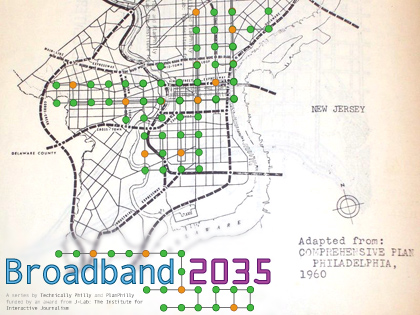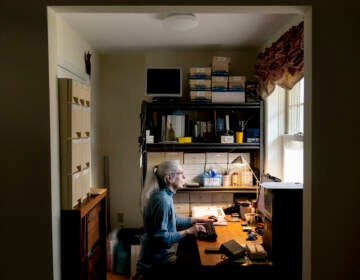Planning Commission sees opportunity in short-term broadband goals for comprehensive plan

This story is distributed in partnership with Technically Philly‘s Broadband2035, a series created to help inform the city’s Philadelphia 2035 comprehensive plan around broadband issues. It is funded by J-Lab.
Philadelphia’s 1960 comprehensive plan was an effort to usher the city’s infrastructure into the future.
Back then, the plan called for build-out that Philadelphians today utilize daily, like the creation of a new tunnel for commuter rail that would cut through Center City to meet peak-hour demands and an expressway that would help connect the city to the suburbs.
For the first time since that plan was drafted more than 60 years ago, the city planning commission is undertaking a new long-term vision for the city’s built environment.
The Philadelphia 2035 Comprehensive Plan will eventually modify zoning around commercial corridors and industrial centers, and lay out new infrastructure and transit lines says Alan Urek, Director of Strategic Planning and Policy at the Philadelphia City Planning Commission. And the commission hopes it will result in improving the city’s economy, health and environmental impact.
“It’s self-evident that transportation and utility infrastructure are economically important. I don’t think we have the same consciousness for broadband,” Division of Technology Chief of Staff Jeff Friedman says.
And lest Philadelphia fall prey, once again, to the shortcomings lended by unpredictability — after all, the comprehensive plan written more than a half-century ago was an optimistic portrait of a city expected to grow in population — the Planning Commission’s take on broadband is that it is impossible to predict how broadband and technology could change over the next 25 years. But even if they don’t know the specifics, Urek says that the plan can still include goals like shrinking the digital divide. “We may not be able to say what that will be in 25 years or 10 years, but from a short term perspective we could probably be more explicit,” Urek says.
Broadband Infrastructure recommendations collected from our readers for Philadelphia 2035
Goal: Treat broadband connectivity as a necessary public utility with the city and citizen in mind.
Objectives:
1. Utilize and improve existing city network infrastructure
- Integrate plans for fiber and wireless assets to reduce the cost of the city’s current data and voice communications and to catalog, track and inform city services
- Increase capacity for next-generation broadband connectivity, starting with Gigabit technology and looking beyond to future connectivity innovations
- Identify neighborhood-based creative economy hubs and support growth through infrastructure improvements and incentives
2. Expand citizen access to broadband
- Improve regulation that allows for the development of competitive commercial broadband
- Explore partnerships with broadband providers and educational institutions to increase the availability and adoption of broadband to low-income residents
- Provide wireless broadband access throughout the public transportation system and the city’s parks system
Technically Philly solicited reader comment on broadband to provide to the Planning Commission, which echoed that sentiment.
Overwhelmingly, our technology-interested community called for improved citizen access to broadband, including exploring changes to regulation that would allow for the development of more competitive commercial broadband access. And experts, involved with and interested in municipal use of broadband infrastructure, called for the improvement of existing city network infrastructure.
Broadband advocates argue that municipal fiber networks are a solid long-term investment, whether they are used to connect police and dispatchers, universities and community centers or if they are used to put high-speed internet in homes and businesses. By replacing traditional copper wires with fiber optic cable, users can receive download and upload speeds of up to 100 megabits per second, according to the Fiber to the Home Council.
Comcast’s newest technology available in the city, Docsis 3.0, currently offers download speeds of 50 mbps and upload speeds of 10 mbps, while Verizon FiOS offers 50 mbps/20mbps. And estimates report that less than 50 percent of residents have access to broadband connectivity in their homes.
Municipal investment in broadband infrastructure can improve the city’s connectivity and economy on a number of levels, Nicol Turner-Lee, an advocate for minority and low-income broadband adoption, said. Turner-Lee has also studied minority broadband adoption as Director of the Media and Technology Institute for the Joint Center for Political and Economic Studies.
“Cities should do an assessment of what their tech needs are, and coordinate not just cables and fiber, but uses of tech to solve community problems,” Turner-Lee said.
Other municipalities have used broadband for information sharing among city departments, Turner-Lee said. City departments and employees can share information digitally. Police would be able to transmit high definition surveillance videos to officers at the scene of a crime. City employees could move to more cloud-based office solutions, she said.
Philadelphia could also improve where it makes investments in fiber from projects that received grant money from the recent NTIA stimulus, she said. Last year, the federal government doled out millions to projects that connect public institutions and business corridors with fiber, providing significantly improved connection speeds. The City of Philadelphia did not receive middle-mile infrastructure awards that could do just that, but it did win millions in broadband adoption grants.
One infrastructure winner, the Keystone Initiative for Network Based Education and Research Network promises to bring 1 Gbps speeds to public institutions across the state, including the University of Pennsylvania and Drexel University. And when their state-wide network is completed, private fiber providers may be able to sell that service to Pennsylvania residents, according to the project’s stimulus application. That could create new competition throughout the state, but construction has yet to begin.
Other projects are aimed at slowing the growth of the digital divide and increasing access for residents who can’t afford access. Broadband could give a boost to public computer facilities like libraries and community centers, Turner-Lee said. The city has already made headway in that department, receiving $11.8 million in federal grant money to open computer centers around the city.
There are countless possibilities on how the city can leverage broadband technology over the next 25 years, and during the course of our Broadband2035 series, we intend to explore some of them.
But experts agree that a basic goal like increasing all residents’ access to high-speed needs to be included in long-term planning.
“We need cities to leverage the technology to solve problems facing different groups in the city,” Turner-Lee says.
Contact the reporter at chris.reber@gmail.com.
WHYY is your source for fact-based, in-depth journalism and information. As a nonprofit organization, we rely on financial support from readers like you. Please give today.






